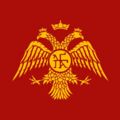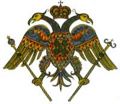Double-headed eagle
The double-headed eagle is the most recognizable symbol of Orthodoxy today (other than the cross) and was the official state symbol of the late Byzantine Empire, symbolising the unity between the Byzantine Orthodox Church and State, which was governed by the principle of Symphonia or Synallelia, that is, a "symphony" between the civil and the ecclesiastical functions of Christian society. In addition, the heads of the eagle also represent the dual sovereignity of the Byzantine Emperor, the left head representing Rome (the West) and the right head representing Constantinople (the East), whilst the claws of the eagle hold a cross, or a sword, and an orb.
Contents
Byzantine Emblem
Emperor Isaacius Comnenus (11th century AD), the first ruling member of the Comnenus dynasty, was the first Emperor who adopted the two headed eagle as the symbol of the Empire.
Orthodox Provenance of the Double-Headed Eagle
The following gallery shows heraldic usages of the double-headed eagle in the history of the Orthodox Church.
The double-headed eagle, the most recognized emblem of the Byzantine Empire, with the dynastic cypher of the Palaiologoi in the center.
Byzantine Empire emblem. The double headed eagle as standing in the front entrance of the Ecumenical Patriarchate of Constantinople.
Flag of both Mount Athos and the Ecumenical Patriarchate of Constantinople.
Emblem of the Church of Greece.
Emblem of the Church of Cyprus.
Emblem of Church of Constantinople and Mount Athos
The modern double-headed eagle flag for the Ecumenical Patriarchate of Constantinople and of Mount Athos, features the eagle with a sword in the right claw symbolizing secular authority, and an orb in the left symbolizing spiritual authority. Above the eagle, is a crown and the background colour of the flag is yellow. (see image below).
Emblem of Russian Empire and Modern Russia
The two major symbolic elements of Russian state and church symbols (the two-headed eagle and St. George slaying the dragon) predate Peter the Great. The double-headed eagle was adopted by Ivan III after his marriage with the Byzantine princess Sophia Paleologo, whose uncle Constantine was the last Byzantine Emperor. After the Fall of Constantinople to the Turks in 1453, Ivan III and his heirs considered Moscow to be the last stronghold of the Christian faith, and in effect, the last Roman Empire (hence the expression "Third Rome" for Moscow and - by extension - for the whole of Imperial Russia).
From 1497, on the double-headed eagle proclaimed a Russian sovereignty equal to that of the Holy Roman Empire of the German Nation. The first remained evidence of the double-headed eagle officialised as an emblem of Russia is on the great prince's seal, stamped in 1497 on a Charter of share and allotment of independent princes' possessions. At the same time the image of gilded double-headed eagle on red background appeared on the walls of the Palace of Facets in the Kremlin.
Diffusion from Byzantium to Various Usages
The two-headed Byzantine Eagle is currently the emblem on the Flags of the Patriarchate of Constantinople and of Mount Athos, as well as those of Serbia, Albania and Montenegro. It has also become the Coat of Arms of modern States including Serbia, Russia, Albania, and most recently Montenegro.
The historic spread of its use occured because the nations that officially adopted Orthodox Christianity - the religion of the Eastern Roman Empire (ΡΩΜΑΝΙΑ/Romania) - as their state religion, had the right to bear the byzantine eagle on their arms if they wanted to, with the corollary that the bearing of the byzantine eagle in gold was a priviledge that only belonged to the sovereign of Constantinople.[1] (See for example, the image of the Imperial Palaeologan eagle, below).
Therefore, the Serbian eagle is depicted in silver. Russia also had the eagle in silver but they changed it to gold (probably in the 15th century after the marriage of Ivan III, Grand Duke of Moscow with Sophia Palaeologina, the daughter of the last Byzantine Emperor & after the fall of Constantinople to the Ottomans), to justify their claim as the "third Rome". Austria on the other hand, earned the right to bear the byzantine eagle, after the marriage of the first German Emperor Otto I in 972, with the niece of Byzantine Emperor Ioannis Tzimiskes, Theophano (and of course the Austrian Empire claimed to be the continuation of the Holy Roman Empire of the Germans). They adopted the byzantine eagle, in black though, as the "shadow of the Imperial Eagle".[2].
Use on Coats of Arms
The two-headed eagle appears on the coat of arms of the following countries[3]:
- Byzantine Empire (historical)
- Albania
- Austria-Hungary (historical)
- German Confederation (historical)
- Russian Empire (historical)
- Russian Federation
- Serbia and Montenegro (historical)
- Pre-WWII Yugoslavia (historical)
- Serbia
- Montenegro
Flags with the Double-Headed Eagle
- Flag of the Ecumenical Patriarchate of Constantinople.
- Flag of Mount Athos.
- Flag of Serbia.
- Flag of Albania.
- Flag of Montenegro (adopted July, 2004).
Notes
- ↑ Military Photos. Byzantine Army and Navy Ranks.
- ↑ Military Photos. Byzantine Army and Navy Ranks.
- ↑ Wikipedia. Double-headed eagle.
External links
- Double-headed eagle on Wikipedia.
- Animal Lover World. Birds Guide: Double-Headed Eagle.
- Military Photos. Byzantine Army and Navy Ranks.
- International Encyclopedia of Uniform Insignia. Uniform Insignia Forum: Greek Armed Forces History.
- Flags of the World. Greek Orthodox Church: Oecumenical Patriarchate of Constantinople.
- Orthodox Church in America (OCA). World Orthodox Churches. (Emblems).





